Authored by Walter Orlando Tenesaca Pintado*,
Abstract
Background and objectives: When an individual changes the pitch of their voice, their vocal folds undergo structural and dynamic variations that produces not only a different sound but also a different vocal pattern and mucosal wave which should be detected accordingly by our analysis tools. Thus, the objective of this work is to assess the changes observed in the correlate of the mucosal wave, in the open and closed phase, when modifying the phonation mode.
Methods: The study analyzed the voice recordings of 160 subjects without voice pathology obtained from the Saarbrucker Stimmdatenbank Institut für Phonetik database. The biomechanical analysis of the voice samples evaluated was performed using the biomechanical analysis tool Voice Clinical Systems®. The selected voice samples were sent to the Voice Clinical Systems® virtual laboratory using the “Analysis for Research” option.
Results: The results show that there is a significant difference (p <0.001) in the mucosal wave values observed in the open and closed phase in relation to the pitch used by the subject. It can be seen how phonation in high tones modifies the biomechanical properties of the free edge and reduces the mucosal wave amplitude. Similarly, phonation in low tones results, regardless of the sex of the subject, in an increase in the mucosal wave effect (p <0.001). Finally, the amplitude of the mucosal wave in opening also shows higher values in the male group than in the female group for all frequencies.
Conclusion: It is important to find evaluation methods and tools that allow us to assess the mucosal wave in an objective and reliable way. The biomechanical analysis of the voice has shown its effectiveness in identifying the changes observed in the mucosal wave effect and derived from the modification of the phonatory pattern. A broader understanding of the mucosal waveform, which complements what is observed during the imaging examination, will help to characterize the voice pathology more precisely and guide towards a more effective treatment.
Keywords: Biomechanical analysis; Dysphonia; Voice pathology; Mucous wave
Introduction and Objetive
The biomechanical study of the voice analyzes the mechanical and structural factors that participate in the development of the movement of the free edge of the vocal folds, using a model based on the underlying histological structure; It allows us in a non-invasive way and from a voice sample to obtain a description of the dynamics of the free edge reflected by a set of biomechanical parameters. This development offers parameters that correlate directly with the mucosal wave effect observed during a given phonation and also enables the characterization of the pathology through parameters that quantify and assess the changes in the mucosal wave [1].
The validity of biomechanical analysis as a tool for evaluating the dynamics of the vocal cycle is established [2]; identifies the variation of vocal behavior patterns in relation to the type of phonation and the presence of pathology through its parameters; it even provides a more complete and accurate description of free edge dynamics than the electroglottogram; It constitutes a valid tool for screening voice pathology, even to discriminate functional pathology [3] (Figures 1, 2).
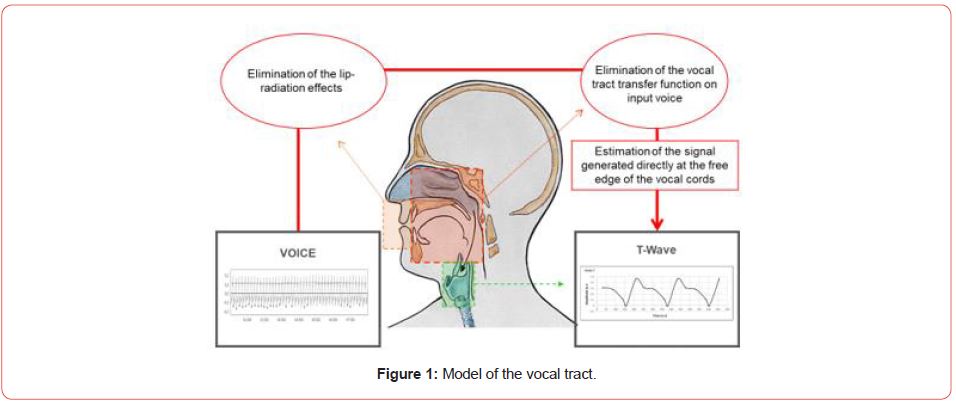
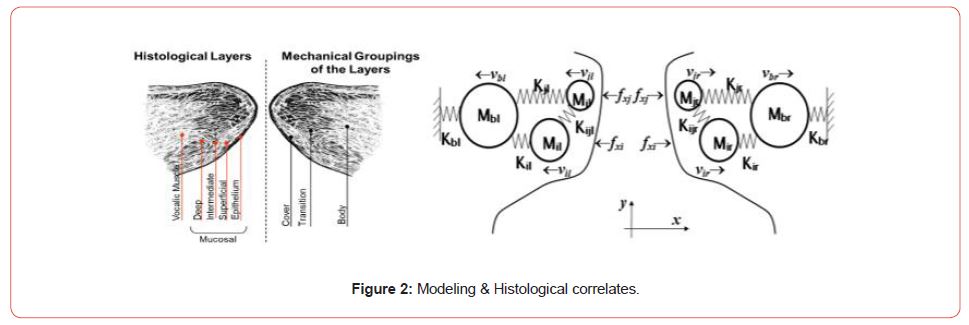
When an individual changes the pitch of their voice, their vocal folds undergo structural and dynamic variations that produces not only a different sound but also a different vocal pattern and mucosal wave which should be detected accordingly by our analysis tools [4, 5]. Thus, the objective of this work is to assess the changes observed in the correlate of the mucosal wave, in the open and closed phase, when modifying the phonation mode.
Materials and Methods
Descriptive study, the study analyzed the voice recordings of 171 subjects without voice pathology obtained from the Saarbrucker Stimmdatenbank Institut für Phonetik database.
The biomechanical analysis of the voice samples evaluated was performed using the biomechanical analysis tool Voice Clinical Systems®. The selected voice samples were sent to the Voice Clinical Systems® virtual laboratory using the “Analysis for Research” option.
The variables studied: age, sex; and parameters of the biomechanical analysis of the voice: fundamental frequency (P01); and characteristics of the mucosal wave such as the degree of amplitude in closed phase (P17) and opening phase (P18); degree of enhancement of the defect in the closed and opening phase, respectively (P19-P20) (Figure 3).

Results and Discussion
The study consisted of 171 subjects; 76 men (44.4%); 95 Women (55.6%); mean age of 28.9 years; standard deviation 12.4 years (Figure 4).
When phonation occurs with low tones, the fundamental frequency (P01) decreases; and in high tones it increases regardless of gender (Figure 5); the analysis of variance found statistically significant differences.
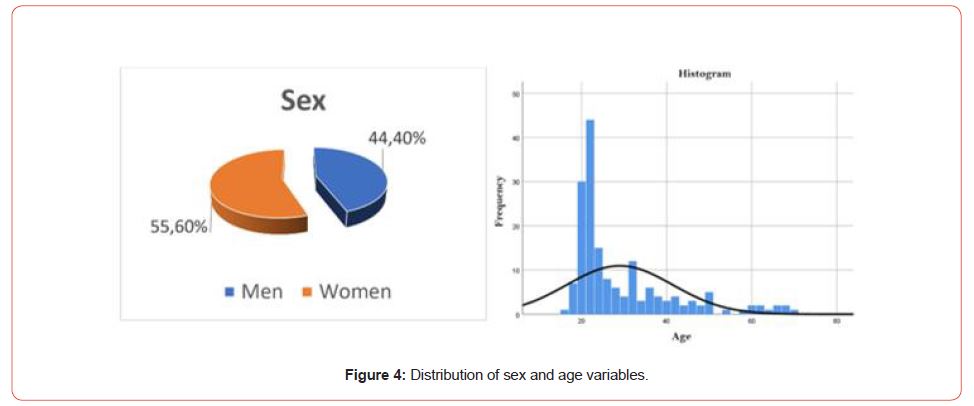

The analysis of variance (95%IC) found statistically significant differences (p < 0.001); changes in the properties of the mucosal wave during phonation; with high tones its amplitude decreases in closed phase (Pr17), the defect rate is minimal (Pr19, Pr20). In the low tones, its amplitude in closed phase (Pr17) increases and the defect indices also increase (Pr19, Pr20). The amplitude in the opening phase (Pr18) also undergoes changes, but without statistically significant differences. In (Figure 6) they are illustrated.
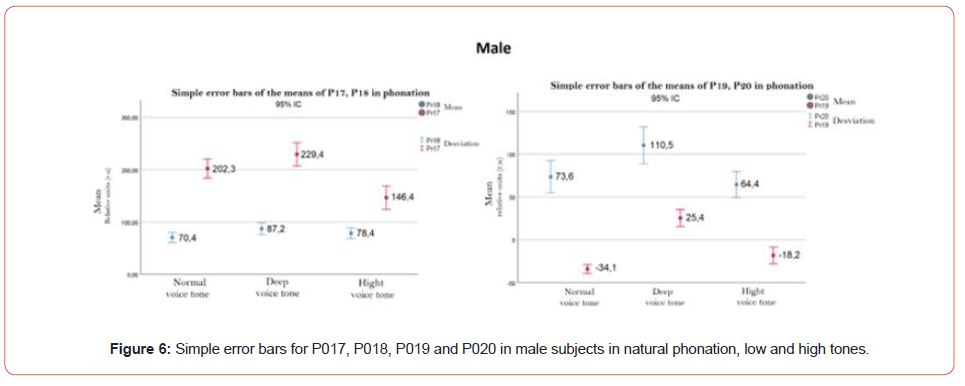
In the same way, statistically significant differences (p < 0.001) were shown in the properties of the free edge and the mucosal wave; with high tones it decreases its amplitude (Pr17) and the index of defect/adaptation in closed phase (Pr19); in phase opening the amplitude (Pr18) and the fault rate (Pr20) are high. In the low tones the amplitude (Pr17-Pr18) increases in all its phases; the opening defect rate increases (Pr20); and decreases in the closing phase (Pr19) (Figure 7).
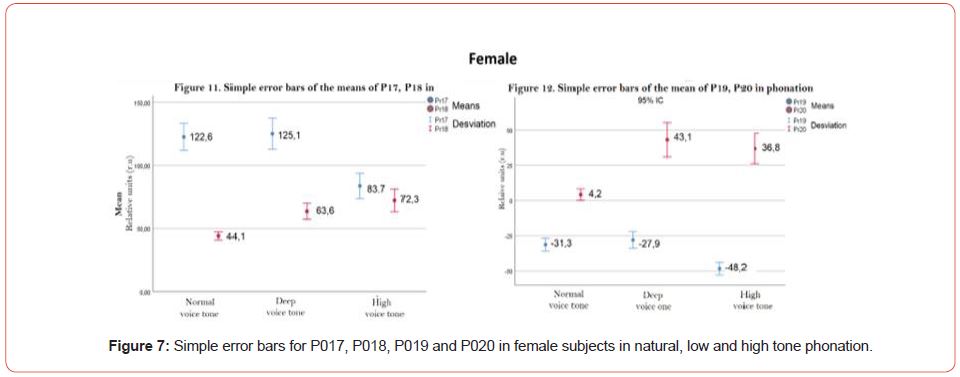
High-pitched phonation modifies the biomechanical properties of the free edge and reduces mucosal wave amplitude. In low tones it produces, regardless of sex, an increase in the mucosal wave effect. Finally, the amplitude of the opening mucosal wave also shows higher values in the male group than in the female group for all frequencies [4-6].
By the interaction of various elements; sex, age, airflow, laryngeal musculature and composition of the vocal folds; phenomena that characterize the human voice will occur. The frequency is inversely proportional to the volume and length of the vocal fold, it is related to age, sex, laryngeal musculature (Figure 8); is directly proportional to its tension and stiffness. With the increase in the speed of vibration in the vocal folds; the amplitude of the mucosal wave decreases; and vice versa [6].
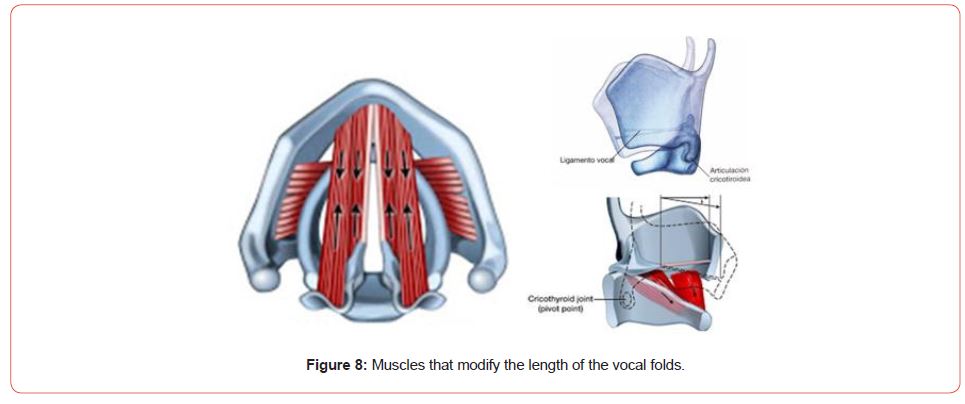
Conclusion
It is important to find evaluation methods and tools that allow us to assess the mucosal wave in an objective and reliable way. The biomechanical analysis of the voice has shown its effectiveness in identifying the changes observed in the mucosal wave effect and derived from the modification of the phonatory pattern. A broader understanding of the mucosal waveform, which complements what is observed during the imaging examination, will help to characterize the voice pathology more precisely and guide towards a more effective treatment.
To read more about this article....Open access Journal of Otolaryngology and Rhinology
Please follow the URL to access more information about this article
To know more about our Journals...Iris Publishers





No comments:
Post a Comment